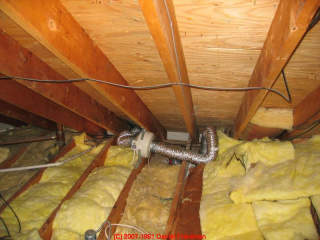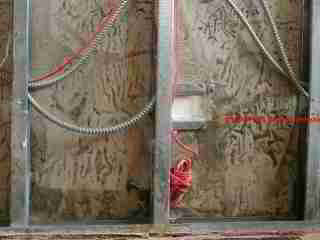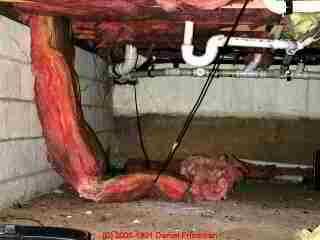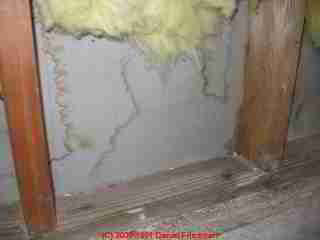 When to Test for Mold in Building Insulation
When to Test for Mold in Building Insulation
- POST a QUESTION or COMMENT about how to decide if testing building insulation for mold contamination is necessary & useful
When should you test building insulation for mold contamination?
This document explains when and why it is appropriate to test for mold contamination or actual mold growth in certain insulation in residential and light-commercial buildings.
This article series discusses health hazards associated with moldy fiberglass in buildings, with focus on fiberglass insulation, fiberglass fragments, fiberglass in heating and air conditioning duct work, and invisible but toxic mold growth in fiberglass which has been wet, exposed to high humidity, or exposed to other moldy conditions.
InspectAPedia tolerates no conflicts of interest. We have no relationship with advertisers, products, or services discussed at this website.
- Daniel Friedman, Publisher/Editor/Author - See WHO ARE WE?
When to test building insulation for mold
 For cost and ethical reasons, we do not recommend testing building insulation for mold as a regular procedure.
For cost and ethical reasons, we do not recommend testing building insulation for mold as a regular procedure.
That is because by no means is it always appropriate or justified to test building materials for mold.
Insulation that has been properly installed, not subjected to water leaks, and not subjected to contamination from external sources such as an improperly-conducted mold remediation job should be fine. (Photo at left).
But sometimes it's a good idea. This article explains how to find or test for moldy insulation in buildings, the probable cause of mold contamination in building insulation, and how to
recognize conditions that make that problem likely in a particular case.
We would recommend inspecting and testing building insulation for mold in the following cases:
- Fiberglass, cotton, or wood product insulation in any building floor, wall, or ceiling cavity which has been wet. In the photo at left some insulation has fallen onto a crawl space floor where it may have been exposed to water entry. All of this insulation, even in the floor overhead, is suspect of mold contamination.
- Fiberglass, cotton, or wood product insulation over wet or damp basements
- Fiberglass, cotton, or wood product insulation over all crawl spaces
- Fiberglass, cotton, or wood product insulation in attics or roof cavities where there has been leakage or where stains show that there has been a history of high attic moisture, condensation, or inadequate ventilation
- Fiberglass, cotton, or wood product insulation in building walls subject to leaks from plumbing failures,previous wetting due to building fire extinguishment, or in freezing climates, walls subject to leaks from ice damming.
- Fiberglass, cotton, or wood product insulation in buildings if it has been exposed or may have been exposed to high levels of airborne mold or moldy dust and debris from other mold contamination problems or from mold remediation projects, especially if the mold remediation project did not make use of good containment and negative air procedures in the work area.
Certainly test, or simply skip testing and just remove any such insulation that is found inside of a mold remediation project area - such insulation should have been removed as part of the cleanup procedure. - Fiberglass heating or cooling duct material, especially if it has been wet from building leaks or A/C condensate mishandling
When Not to Test Building Insulation for Mold

Visible evidence of extensive mold contamination may already indicate that insulation needs to be replaced: Insulation that obviously needs to be replaced because it has been in contact with or exposed to heavy mold contamination such as the Memnoniella echinata - contaminated wall cavity in this New York City apartment does not need to be tested. It needs to be replaced.
Exception: for medical reasons such as to provide possibly helpful environmental information to a treating physician, we may test a building or building materials to identify contaminants.
Furthermore if insulation has been soaked from a building leak or fire extinguishment, it should be replaced regardless, and testing is probably not necessary.
Non-suspect low-risk cases of fiberglass insulation: we do not recommend routine testing of building fiberglass for mold in non-suspect cases such as where insulation is new and/or has not been exposed to water, dampness, or other mold contamination sources.
"Spot checks" by "mold testing" in buildings, if conducted without an expert diagnostic visual inspection and history gathering, are simply not reliable and thus not cost-justified.
Other building insulation materials that are not conducive to mold growth: such as
- fire-retardant treated cellulose insulation
- closed-cell insulating foams (though we have found Cladosporium sp. and on occsaion other mold growths on the surface of foam board insulation that has become wet and soiled or dusted with dust that contains organic debris such as pet dander and hair).
are unlikely to be mold-contaminated but might need to be replaced anyway if damaged or soaked.
Watch out: leaving wet building insulation in place during a restoration project is asking for a future mold contamination issue in the building.
Low-risk buildings where there are no building-related occupant health or air quality complaints:
See MOLD / ENVIRONMENTAL EXPERT, HIRE ? for more detailed advice on deciding when it is appropriate to hire a professional or to perform further mold testing in a building.
...
Continue reading at TEST CHOICES for MOLD in FIBERGLASS or select a topic from the closely-related articles below, or see the complete ARTICLE INDEX.
Or see these
Recommended Articles
- BLOWER LEAKS, RUST & MOLD for Readers concerned with mold contamination in heating and air conditioning air handlers and ductwork
- FIBERGLASS AIR DUCT MOLD TEST - using tape to test & identify debris on HVAC duct interior surfaces
- FIBERGLASS INSULATION MOLD - home
- INSPECTION of INSULATION for MOLD before testing - noting that contaminated building insulation may look clean to the naked eye.
- INSULATION MOLD CONTAMINATION TEST
- INSULATION STAINS - AIR BYPASS LEAKS
- TEST CHOICES for MOLD in FIBERGLASS
- TEST PROCEDURE for MOLD in FIBERGLASS
- VACUUM TEST INSULATION CONTAMINANTS
- WHEN to TEST INSULATION for MOLD
- WHY DOES MOLD GROW in INSULATION? that includes photos and test results examining suspected mold on the surface of fiberglass-lined HVAC ductwork.
Suggested citation for this web page
WHEN to TEST INSULATION for MOLD at InspectApedia.com - online encyclopedia of building & environmental inspection, testing, diagnosis, repair, & problem prevention advice.
Or see this
INDEX to RELATED ARTICLES: ARTICLE INDEX to MOLD CONTAMINATION & REMEDIATION
Or use the SEARCH BOX found below to Ask a Question or Search InspectApedia
Ask a Question or Search InspectApedia
Try the search box just below, or if you prefer, post a question or comment in the Comments box below and we will respond promptly.
Search the InspectApedia website
Note: appearance of your Comment below may be delayed: if your comment contains an image, photograph, web link, or text that looks to the software as if it might be a web link, your posting will appear after it has been approved by a moderator. Apologies for the delay.
Only one image can be added per comment but you can post as many comments, and therefore images, as you like.
You will not receive a notification when a response to your question has been posted.
Please bookmark this page to make it easy for you to check back for our response.
IF above you see "Comment Form is loading comments..." then COMMENT BOX - countable.ca / bawkbox.com IS NOT WORKING.
In any case you are welcome to send an email directly to us at InspectApedia.com at editor@inspectApedia.com
We'll reply to you directly. Please help us help you by noting, in your email, the URL of the InspectApedia page where you wanted to comment.
Citations & References
In addition to any citations in the article above, a full list is available on request.
- BASEMENT MOLD includes examples of moldy fiberglass insulation found in basements
- CRAWLSPACE MOLD includes additional examples of moldy fiberglass insulation found in crawl spaces
- Fiberglass in Indoor Air, HVAC ducts, and Building Insulation, Indoor Air Quality Investigations, building insulation and HVAC duct work insulation hazards
- Insulation Identification Photographs - Fiberglass insulation photos, yellow, pink, green, white fiberglass identification in building attics, walls, ducts, other locations
- Insulation Identification Photographs - Cellulose insulation photos, Mineral wool insulation photos, rock wool insulation photos, cotton insulation photos, balsam wool insulation photos
- Insulation Identification Photographs - Vermiculite insulation photos
- LAB IDENTIFICATION OF FIBERGLASS photographs and text assist in laboratory identification of fiberglass fibers and fragments in air, dust, or material samples in the laboratory using forensic microscopic techniques.
- Mold in Fiberglass building insulation, when, why, and how fiberglass becomes a reservoir of problem mold in buildings.
- World Trade Center Dust Particle Identification
- Fiberglass carcinogenicity: "Glass Wool Fibers Expert Panel Report, Part B - Recommendation for Listing Status for Glass Wool Fibers and Scientific Justification for the Recommendation", The Report on Carcinogens (RoC) expert panel for glass wool fibers exposures met at the Sheraton Chapel Hill Hotel, Chapel Hill, North Carolina on June 9-10, 2009, to peer review the draft background document on glass wool fibers exposures and make a recommendation for listing status in the 12th Edition of the RoC. The National Institute of Environmental Health Sciences is one of the National Institutes of Health within the U.S. Department of Health and Human Services. The National Toxicology Program is headquartered on the NIEHS campus in Research Triangle Park, NC. The National Institute of Environmental Health Sciences is one of the National Institutes of Health within the U.S. Department of Health and Human Services. The National Toxicology Program is headquartered on the NIEHS campus in Research Triangle Park, NC.
Following a discussion of the body of knowledge, the expert panel reviewed the RoC listing criteria and made its recommendation. The expert panel recommended by a vote of 8 yes/0 no that glass wool fibers, with the exception of special fibers of concern (characterized physically below), should not be classified either as known to be a human carcinogen or reasonably anticipated to be a human carcinogen. The expert panel also recommended by a vote of 7 yes/0 no/1 abstention, based on sufficient evidence of carcinogenicity in well-conducted animal inhalation studies, that special-purpose glass fibers with the physical characteristics as follows longer, thinner, less soluble fibers (for 1 example, > 15 μm length with a kdis of < 100 ng/cm2/h) are reasonably anticipated to be a human carcinogen for the listing status in the RoC. The major considerations discussed that led the panel to its recommendation include the observations of tumors in multiple species of animals (rats and hamsters). Both inhalation and intraperitoneal routes of exposure produced tumors, although inhalation was considered more relevant for humans. - Fiberglass insulation mold: occurrence of mold contamination in fiberglass insulation can be impossible to see with the naked eye, but can be significant
- World Health Organization International Agency for Research on Cancer - IARC Monographs on the Evaluation of Carcinogenic Risks to Humans - VOL 81 Man-Made Vitreous Fibers, 2002, IARCPress, Lyon France, pi-ii-cover-isbn.qxd 06/12/02 14:15 Page i - World Health Organization, 1/21/1998. - Fiberglass insulation is an example of what IARC refers to as man made vitreous fiber - inorganic fibers made primarily from glass, rock, minerals, slag, and processed inorganic oxides. This article provides enormous detail about fiberglass and other vitreous fibers, and includes fiberglass exposure data.
- WHO- World Health Organization - IARC MONOGRAPHS ON THE IDENTIFICATION OF CARCINOGENIC HAZARDS TO HUMANS large PDF over 6MB)
https://publications.iarc.fr/ENG/Monographs/vol81/mono81-6A.pdf - article details
https://publications.iarc.fr/ENG/Monographs/vol81/mono81-6C.pdf - studies of cancer in experimental animals in re vitreous fibers such as fiberglass;
https://publications.iarc.fr/ENG/Monographs/vol81/mono81-6E.pdf - summary of data reported & evaluation
https://publications.iarc.fr/ENG/Monographs/vol81/mono81-6F.pdf for the article references
To search the IARC monographs on various environmental concerns and carcinogens, use https://publications.iarc.fr/ENG/Monographs/PDFs/index.php - ENVIRONMENTAL HEALTH & INVESTIGATION BIBLIOGRAPHY - our technical library on indoor air quality inspection, testing, laboratory procedures, forensic microscopy, etc.
- Adkins and Adkins Dictionary of Roman Religion discusses Robigus, the Roman god of crop protection and the legendary progenitor of wheat rust fungus.
- [3] Kansas State University, department of plant pathology, extension plant pathology web page on wheat rust fungus: see http://www.oznet.ksu.edu/path-ext/factSheets/Wheat/Wheat%20Leaf%20Rust.asp
- [4] "A Brief Guide to Mold, Moisture, and Your Home", U.S. Environmental Protection Agency US EPA - includes basic advice for building owners, occupants, and mold cleanup operations. See http://www.epa.gov/mold/moldguide.htm
- [5] Ahearn, D.G., S A Crow, R B Simmons, D L Price, J A Noble, S K Mishra and D L Pierson, "Fungal colonization of fiberglass insulation in the air distribution system of a multi-story office building: VOC production and possible relationship to a sick building syndrome", Journal of Industrial Microbiology & Biotechnology, Volume 16, Number 5 (1996), 280-285, DOI: 10.1007/BF01570035. Abstract:
Complaints characteristic of those for sick building syndrome prompted mycological investigations of a modern multi-story office building on the Gulf coast in the Southeastern United States (Houston-Galveston area). The air handling units and fiberglass duct liner of the heating, ventilating and air conditioning system of the building, without a history of catastrophic or chronic water damage, demonstrated extensive colonization with Penicillium spp and Cladosporium herbarum. Although dense fungal growth was observed on surfaces within the heating-cooling system, most air samples yielded fewer than 200 CFU m–3. Several volatile compounds found in the building air were released also from colonized fiberglass. Removal of colonized insulation from the floor receiving the majority of complaints of mouldy air and continuous operation of the units supplying this floor resulted in a reduction in the number of complaints. - [6] Ahearn, D.G., S.A. Crow, R.B. Simmons, D.L. Price, S.K. Mishra and D.L. Pierson, "Fungal Colonization of Air Filters and Insulation in a Multi-Story Office Building: Production of Volatile Organics", Current Microbiology Volume 35, Number 5 (1997), 305-308, DOI: 10.1007/s002849900259, Abstract:
Secondary air filters in the air-handling units on four floors of a multi-story office building with a history of fungal colonization of insulation within the air distribution system were examined for the presence of growing fungi and production of volatile organic compounds. Fungal mycelium and conidia of Cladosporium and Penicillium spp. were observed on insulation from all floors and both sides of the air filters from one floor. Lower concentrations of volatile organics were released from air filter medium colonized with fungi as compared with noncolonized filter medium. However, the volatiles from the colonized filter medium included fungal metabolites such as acetone and a carbonyl sulfide-like compound that were not released from noncolonized filter medium. The growth of fungi in air distribution systems may affect the content of volatile organics in indoor air. - [7] Price,D. L., R. B. Simmons, I. M. Ezeonu, S. A. Crow and D. G. Ahearn, "Colonization of fiberglass insulation used in heating, ventilation and air conditioning systems", Journal of Industrial Microbiology & Biotechnology Volume 13, Number 3 (1994), 154-158, DOI: 10.1007/BF01584000, Abstract: The number of fungal species colonizing thermal and acoustic fiberglass insulations used in heating, ventilation, and air conditioning (HVAC) systems was fewer than that obtained from initial direct culture of these insulations. The colonization, determined by the microscopic observation of conidiophores with conidia, was primarily of acrylic-latex-facing material, but eventually the fungi permeated the fiberglass matrix. Isolates of Aspergillus versicolor were most often obtained from non-challenged insulation, whereasAcremonium obclavatum appeared to be the primary colonizing fungus in high-humidity (>90%) challenge chambers. At a lower humidity (about 70%) Aspergillus flavus was one of the more prominent fungi. Not all duct liner samples were equally susceptible to colonization and duct board appeared relatively resistant to colonization.
- [8] Simmons, R. B. and S. A. Crow, "Fungal colonization of air filters for use in heating, ventilating, and air conditioning (HVAC) systems", Journal of Industrial Microbiology & Biotechnology Volume 14, Number 1 (1995), 41-45, DOI: 10.1007/BF01570065, Abstract:
New and used cellulosic air filters for HVAC systems including those treated with antimicrobials were suspended in vessels with a range of relative humidities (55–99%) and containing non-sterile potting soil which stimulates fungal growth. Most filters yielded fungi prior to suspension in the chambers but only two of 14 nontreated filters demonstrated fungal colonization following use in HVAC systems. Filters treated with antimicrobials, particularly a phosphated amine complex, demonstrated markedly less fungal colonization than nontreated filters. In comparison with nontreated cellulosic filters, fungal colonization of antimicrobial-treated cellulosic filters was selective and delayed. - [9] Ifeoma M. Ezeonu, Daniel L. Price, Sidney A. Crow and Donald G. Ahearn, "Effects of extracts of fiberglass insulations on the growth of Aspergillus fumigatus and A. versicolor", Mycopathologia Volume 132, Number 2 (1995), 65-69, DOI: 10.1007/BF01103777
, Abstract:
Water extracts of thermal and acoustic fiberglass insulations used in the duct work of heating, ventilation and air conditioning (HVAC) systems supported germination of conidia and growth of Aspergillus versicolor (Vuillemin) Tiraboschi 1908–9 and Aspergillus fumigatus Fresenius 1863. Urea, formaldehyde and unidentified organics were detected in the extracts. Formaldehyde in concentrations similar to those found in the extracts restricted the growth of both species in enriched media. A. versicolor, the more common species associated with fiberglass insulations, was more resistant to formaldehyde than A. fumigatus. - [10] US EPA - Mold Remediation in Schools and Commercial Building [ copy on file as /sickhouse/EPA_Mold_Remediation_in_Schools.pdf ] - US EPA
- [11] US EPA - UNA BREVA GUIA a MOHO / HONGO - en Espanol
- In addition to citations & references found in this article, see the research citations given at the end of the related articles found at our suggested
CONTINUE READING or RECOMMENDED ARTICLES.
- Carson, Dunlop & Associates Ltd., 120 Carlton Street Suite 407, Toronto ON M5A 4K2. Tel: (416) 964-9415 1-800-268-7070 Email: info@carsondunlop.com. Alan Carson is a past president of ASHI, the American Society of Home Inspectors.
Thanks to Alan Carson and Bob Dunlop, for permission for InspectAPedia to use text excerpts from The HOME REFERENCE BOOK - the Encyclopedia of Homes and to use illustrations from The ILLUSTRATED HOME .
Carson Dunlop Associates provides extensive home inspection education and report writing material. In gratitude we provide links to tsome Carson Dunlop Associates products and services.



